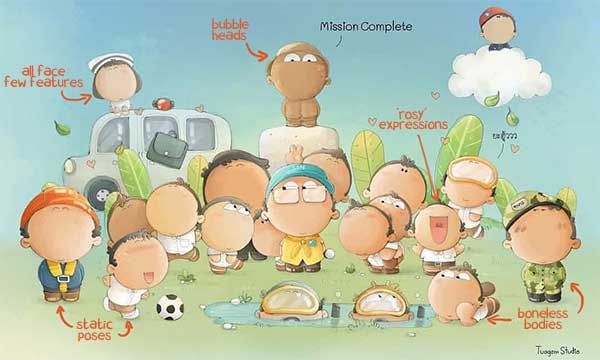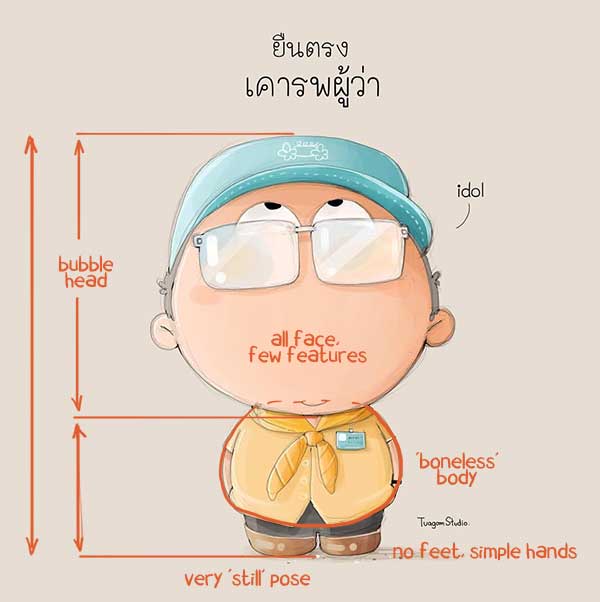Drawing Cute Cartoons

Image credit: Tuagom Studio (annotations added for teaching purposes only)
I spent the first week of July scuba diving. Clear tropical waters teeming with reef fish — it was a far cry from conditions facing the helpers mounting the Thai boys’ cave rescue mission in the face of monsoon rains.
When I emerged from my holiday rescue efforts were in top gear, but having missed the beginning of it I only caught up after the dramatic, but largely successful conclusion. It was then that I became aware of the incredible cartoons folks had been drawing to document all that was happening.
Thosee cartoons were remarkable
With the FIFA world cup dominating headlines, there were bound to be images linking the Thai boys’ football team to the international action but that wasn’t what caught my eye. It was the documentary nature of a particular set of images, which was also my introduction to Japanese kawaii.
The ’culture of cuteness’ approach?
Apparently drawing cute cartoons is common throughout South East Asia, the style originates in Japan and has a name — ‘kawaii’ — something of which I had never been aware before.
Of course I had noticed the stylised cuteness of Hello Kitty, Pokemon and manga in general: the fact that even adult characters are often portrayed in ways that make them look very young and sweet. But I had no idea that cuteness is Officially A Thing in Japanese art. I feel a little as if I have been living under a rock ?.
Do you have an affinity for drawing cute cartoons?
I confess that I do, though I’ve often tried to avoid it! However, as my drawing style tends towards children’s book illustration the idea of exploring the how-to’s of cuteness exemplified in these cartoons immediately took my fancy.
Five pointers for drawing cute cartoons Tuagom-Studio-style
- Bubble heads
- All faces, few features
- Rose-tinted expressions
- ‘Boneless’ bodies
- Static positions

Image credit: Tuagom Studio (annotations added for teaching purposes only)
Bubble heads
Having a huge head always creates an impression of youthfulness, but cartoonist Pazut Wutigornsombatkul (drawing under his Tuagom Studio name) takes it to extremes. The head accounts for more than half of the total height of the characters and unusually, the only way to distinguish between adult and child characters is through the overall height, rather than a shift in head-size-vs-overall-height proportions.
All face, few features
When you look at each face the overwhelming impression is of roundness or circles, and an expanse of plump cheeks. There are no noses; the eyes are up close to the hairline and the mouth placed way down near the chin. It gives an undefined, slightly angelic look to each face, and individuality is supplied by hairstyles rathhttps://www.instagram.com/tuagomstudio/?hl=ener than individual face shapes.
‘Rose-tinted spectacle’ expressions
From the warmly tinted cheeks and neutral or happy mouth shapes, the face expressions give the impression of rather delighted cherubs, anticipating wonderful outcomes at any minute.
‘Boneless’ bodies
The torsos are gently rounded with clothes fitting within a circular outline. Arms have no elbows and often no hands and the legs and feet are short columns, with no defined knees.
(Relatively) static poses
Even moving characters are stylised and still. This is largely function of having no obvious knee or elbow joints — as mentioned above — which means there are no acute angles even when the character is in motion.
Beyond character design, what else contributes drawing cute cartoons in this style?
There are three style elements that enhance and deepen to the cute and childlike mood of Wutigornsombatkul’s beautiful images, all of them relatively simple to emulate. These are his fine, uniform-width outlines; the pastel colour palette he uses and finally the simple, almost naïve (in artistic terms) representations of objects, scenery and plant life.
So there you have it! Eight points in total that will help you either improve at drawing cute cartoons, or navigate away from cuteness if it’s not something you want to embrace even by accident.
Here’s a quick crib list for drawing cute cartoons
- Bubble heads — use large, round heads, make more than 50% of the total character height
- All cheeks, tiny features — let the cheeks stage a takeover, leave out the nose, place eyes up high and the mouth down low
- Rose-tinted expressions — small upward curving mouths or wide-open D-shaped grins keep everything cheerful
- ‘Boneless’ bodies – fit the torso into a soft oval and avoid obvious knee and elbow joints. Hands and feet have little definition
- Static positions – even at a full run, keep angles gentle and don’t make the limbs bend at the knees and elbows.
- use fine, light outlines
- use pastel colour tones
- use a stylised rather than a realistic approach to drawing details in scenes.
This post came about as a result of The Guardian newspaper’s article about how cartoonists in Thailand chronicled the course of the rescue mission for the young footballers trapped in the Tham Luong caves.
The work of Pazut Wutigornsombatkul of Tuagom Studio is beautiful as well as inspiring, so do follow his regular posts on Instagram.
***
Questions? Suggestions?
I’d love to hear from you. Leave a comment and who knows? Your question could spark off an exciting new lesson series!
***
Coming soon!
Get Sticky! The Stickman to Cartoons Step-by-Step Workbook
and
5 Minute Mindfulness (With A Pencil): a mindfulness mini-course that delivers a creative state of mind without a formal meditation practice.
To get more lessons and tips weekly via email, sign up here and start your FREE digital micro-class “Stickmen to Cartoons”.
